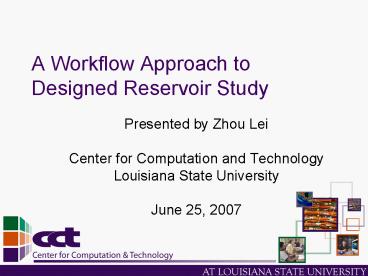A Workflow Approach to Designed Reservoir Study PowerPoint PPT Presentation
1 / 23
Title: A Workflow Approach to Designed Reservoir Study
1
A Workflow Approach to Designed Reservoir Study
- Presented by Zhou Lei
- Center for Computation and Technology
- Louisiana State University
- June 25, 2007
2
Outline
- Background
- Reservoir uncertainty analysis
- Workflow implementation
- Workflow management
- Future work
3
Oil Industry in Louisiana
- Major oil producing state in US
- 5th in production
- 8th in reserves
- Home to 2 of 4 strategic petroleum reserves
- 17 petroleum refineries (capacity 2.8M
barrels/day) - Ports receive ultra large oil tankers
- 20,000 oil producing wells, around 4K offshore.
4
UCOMS
- Ubiquitous Computing Monitoring System for
Discovery Management of Energy Resources - DOE/Louisiana BOR funded
- Petroleum engineering
- Wireless sensor networks
- Grid technologies
- Applications
- Reservoir simulation
- Uncertainty analysis, sensitivity studies,
history matching - Real-time well surveillance
- Drilling performance analysis with high-rate data
5
Reservoir Studies
- Assessments and predictions of oil/gas reservoir
performance, depending on - Geological heterogeneity
- Engineering choices
- Used for development and operational decisions
models assess different production scenarios. - Applications
- Well placement performance prediction
- Sensitivity analysis uncertainty assessment
- History matching (model verification and tuning)
6
Core Computational Needs
- Compute
- Large-scale computation Seismic inversion, flow
numerical simulations, Geostatistics, analysis, - Data
- Large data sets (TB-PB) Seismic, Geological
Geophysical (GG), Well logging, Simulation
results, - Security
- Commercial benefits lead to high security for all
data, proprietary codes, etc. - Workflow
- Parameter selection, model construction, data
movement, model deployment, results analysis etc. - Move towards dynamic, data driven scenarios,
including direct input from sensor data.
7
Participants of reservoir studies
- Advisory faculty Gabrielle Allen, Chris White,
John Smith. - Reservoir modeling Xin Li.
- Workflow Promita Chakraborty, Chongjie Zhang,
John Lewis (under graduate). - Data management Dayong Huang.
- Compute management Zhou Lei.
8
Reservoir Uncertainty Analysis
- Understand the effect of uncertainty in reservoir
studies to guide development and operational
decisions - Uncertainty in different (geological) parameters
(factors) - Response surfaces are built from observational
and simulation data to model parameter effect - Experimental design techniques help reduce the
parameter space which needs to be explored.
9
Reservoir Uncertainty Analysis
- Factors (parameters) in reservoir studies are
classified into - Controllable Can be varied by process
implementers, e.g. Well Location, injection rate,
- Observable Can be relatively accurately measured
but not controlled, e.g. Depth to a structure, - Uncertain Cannot be accurately measured or
controlled, e.g. Permeability far from wells, - Factors
- Geological (pressure, permeability, water
saturation, critical gas saturation, gas/water
end points, gas/water Corey exponents, non-Darcy
coefficient, aquifer size, anisotropy ration, ) - Engineering (completion length ration, tubing
head pressure, tubing diameter, ).
10
Reservoir Uncertainty Analysis
- Responses to factors are obtained
- by models or measurement.
- Reservoir studies concerned with
- responses affecting value, e.g.
- Peak oil rate
- Cumulative oil recovery
- A response surface model is an empirical fit to
reservoir simulation results
11
Designed reservoir study workflow
12
Designed reservoir study workflow
- Characterization base model
- Simulation model construction
- Simulation
- Geostatistical realization
- Data conversion
- Reservoir simulation (flow numerical simulation)
- Post processing
- Response surface modeling
- Visualization
13
Workflow implementation across Grid
14
Workflow implementation across Grid
15
Workflow implementation across Grid
16
Workflow management
- Grid portal
- Workflow creation
- Workflow tracking
- Workflow reuse
17
Workflow management
18
Workflow management
19
Workflow management
20
Workflow management
21
Workflow management
22
Workflow management
23
Future work

